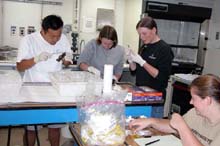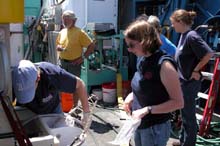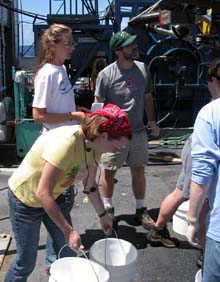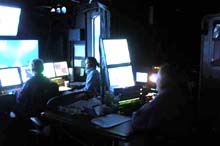
Walter Cho, Sarah L'Heureux, Rhian Waller and Kate Buckman, all of the Woods Hole Oceanographic Institution, process specimens. Click image for larger view and image credit.
Tales from a Newbie
September 3 , 2005
Sarah L'Heureux
Woods Hole Oceanographic Institution
I've never been at sea for more then a few hours before, never out of sight of land. Now I'm stuck on a 274 foot ship, literally in the middle of the Atlantic , for over 3 weeks. Crazy! I'm going to be a senior at the University of Delaware when I get back to land but for now I am a very fortunate Summer Student Fellow at WHOI. I had no idea what to expect when I was told I had the opportunity to go on the DASS cruise, but I didn't really have time to worry about it, because we were leaving in only about 2 weeks and I had a boatload (if you will) to do to finish in lab and also to prepare for a long cruise.

Rhian Waller and Sarah L'Heureux of the Woods Hole Oceanographic Institution retrieve specimens from the ROV Hercules. Click image for larger view and image credit.
When finally I was on board, I still had no idea what to expect, except for a really loud berth down just aft of the bow thrusters. Super. In no time, however, we had our first dive and I had to do my duties as Data Logger. Basically these entail ensuring the entire dive is being recorded from cameras on both ROVs (Argus and Hercules) onto DVDs and DVCam tapes, logging information about the samples collected, ship moves, etc. The best part about it is the location within the control van, which is merely a storage container on the outside but a sci-fi movie on the inside (photo below). Watching the Hercules pilot (Todd Gregory usually, on my watch) maneuver the manipulator arm to pluck a wispy, delicate coral from off of the basalt and drop it into the 'bioboxes' might be the most amazing -- not to mention entertaining -- thing I've seen since I watched the crew expertly lower first Hercules in the water to sputter around at the surface while Argus was being simultaneously wrangled by the crew and IFE team and lowered by the winch.

Sarah L'Heureux of the Woods Hole Oceanographic Institution participates in the 'bucket brigade', while Anne Simpson of the University of Maine, and Scott France of the University of Louisiana 'assist.' Click image for larger view and image credit.
At the end of the dives, which usually occur on my watch, I watch the ascent which takes roughly 1-2 hours. After that it's time for the only part of the dive that is rather unpleasant: the Bucket Brigade. Keeping the samples alive is very important to everyone's project except Alex and his fossil corals because, well, they have been dead for tens of thousands of years and aren't going to get any deader. In order to keep the more lively corals in good shape, we need to keep them in cold sea water and also refrigerated until we can process them. This requires us to drag about 20 - 5 gallon buckets full of cold water out to the fantail where the ROVs are. When we get the 'all clear' sign from the crew, we finally get to go see the beautiful booty. One or two at a time then, the full buckets, now each containing a coral, are brought back down the hall to the walk in fridge. I'd like to think that I'm nothing of a weakling, but I am about 5'2" and there just no easy way to carry full buckets of water. Moving on...

In the control van, Sarah L'Heureux of the Woods Hole Oceanographic Institution performs her data logger duties, while in the background, Todd Gregory of the Institute for Exploration pilots the ROV Hercules, and Alicia Caporaso of the University of Rhode Island navigates. Click image for larger view and image credit.
Processing samples is probably the most exciting part of the day. Just about everyday we can find something that no one has seen before, my favorite discovery being when my advisor, Tim Shank, dissected an egg and found a 'Dumbo' octopus embryo. But then the corals themselves are stunning as well. The skeletons from the iridogorgias (as you can imagine from the name) look like iridescent metal springs. The metallogorgias always have a delicate brittle star coiling its legs among the branches. The most surprising thing to me is the amount of color that is present in the blackness of the deep sea.
I am very fortunate to have this opportunity and am looking forward to seeing more amazing, 'never before seen' sights during the remaining dives.
Sign up for the Ocean Explorer E-mail Update List.
























